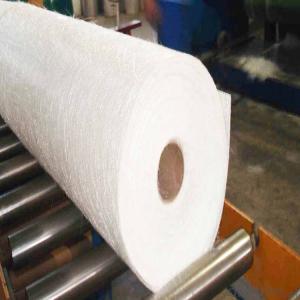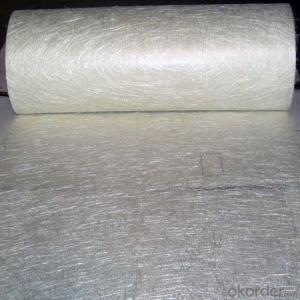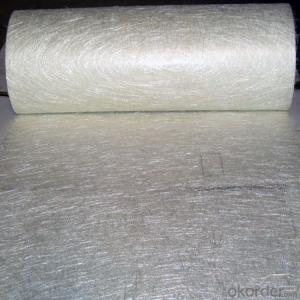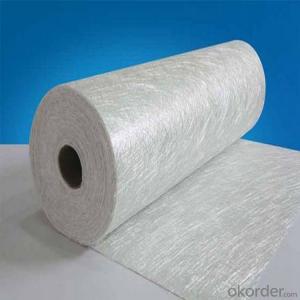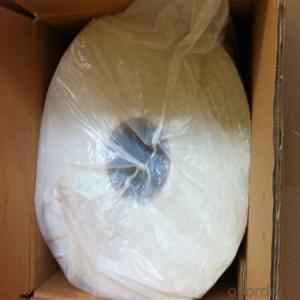Fiberglass Chopped Strand Mat Combination Mat Slide Mat
- Loading Port:
- China main port
- Payment Terms:
- TT OR LC
- Min Order Qty:
- 1 kg
- Supply Capability:
- 5000 kg/month
OKorder Service Pledge
OKorder Financial Service
You Might Also Like
Product Description:
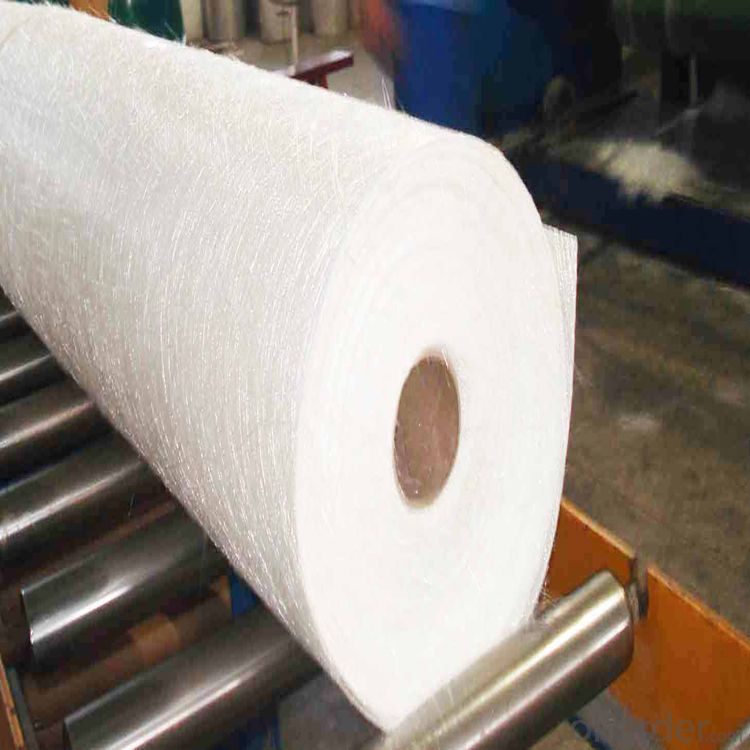
Surfacing Tissue mainly used in the surface layers of FRP products. It features even Fiber distribution, soft feel, level and smooth fiber surface, less glue content, quick resin soak and good pattern fitness. It can improve the product surface property on corrosion resistance, compressive strength, seepage resistance, and longer service life. It is also suitable for spraying; pattern pressing and other FRP pattern technology.
Surfacing Tissue mainly used in the surface layers of FRP products. It features even Fiber distribution, soft feel, level and smooth fiber surface, less glue content, quick resin soak and good pattern fitness. It can improve the product surface property on corrosion resistance, compressive strength, seepage resistance, and longer service life. It is also suitable for spraying; pattern pressing and other FRP pattern technology.
Product Features:
Fast breakdown in styrene
Fiber dispersed evenly
Low binder content
Superior acid corrosion resistance
Specifications:
Item | Over Density | Moisture Content | Chop Density | Polyester Yarn | Width |
(g/m2) | (%) | (g/m2) | (g/m2) | (mm) | |
EMK300 | 309.5 | ≤0.15 | 300 | 9.5 | 50-3300 |
EMK380 | 399 | 380 | 19 | ||
EMK450 | 459.5 | 450 | 9.5 | ||
EMK450 | 469 | 450 | 19 | ||
EMC0020 | 620.9 | 601.9 | 19 | ||
EMC0030 | 909.5 | 900 | 9.5 |
Product Packaging:
Each Surface Tissue is wound onto a paper tube which has an inside diameter of 76mm and the mat roll has a diameter of 330mm. The mat roll is wrapped up with plastic film,and then packed in a cardboard box or wrapped up with kraft paper. The rolls can be vertically or horizontally placed. For transportation, the rolls can be loaded into a cantainer directly or on pallets.
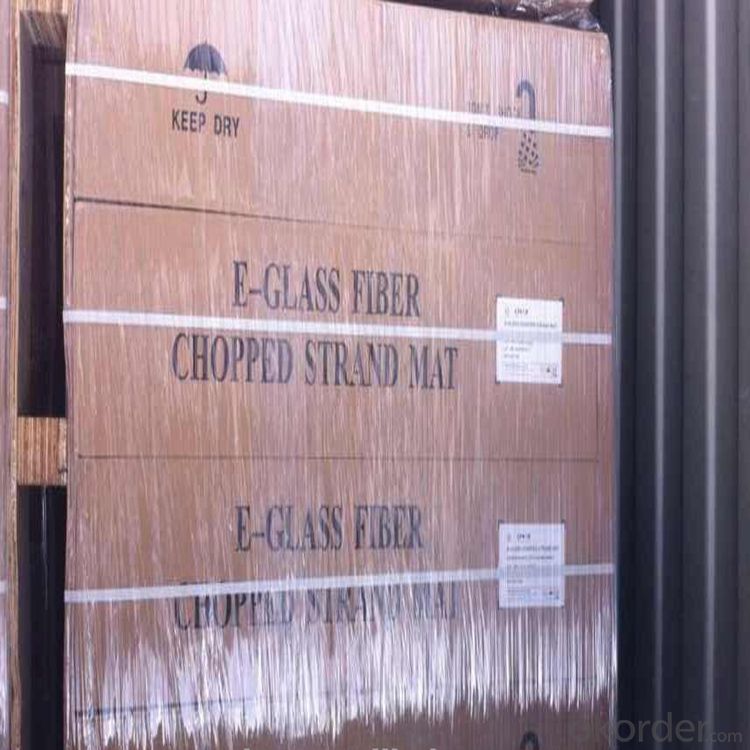
Product Storage:
Unless otherwise specified, Chopped Strand Mat should be stored in a dry, cool and rain-proof area. It is recommended that the room temperature and humidity should be always maintained at 15℃~35℃ and 50%~75% respectively.
Company Information
CNBM (China National Building Material) Group is the largest comprehensive building materials group in China that in integrate scientific research, manufacturing and logistics into one entity. The largest building materials and equipment specialists in China. Upon State Council approval, today CNBM owned more than 300 subordinate manufacturing factories and servicing companies. There are 6 fully owned public listed companies and 11 partially owned with substantial shares public listed companies. In many of these fields, CNBM is playing the leading role in the building industry in the country.

- Q:How does the fiber aspect ratio affect the performance of chopped strand composites?
- Determining the performance of chopped strand composites is greatly influenced by the fiber aspect ratio. The aspect ratio, which is the ratio of fiber length to fiber diameter, plays a crucial role in this regard. Typically, composites containing fibers with higher aspect ratios display improved mechanical properties. The inclusion of longer fibers ensures a more continuous reinforcement within the composite matrix, resulting in enhanced stiffness, strength, and fatigue resistance. This is due to the longer fibers creating a more efficient load transfer mechanism, which evenly distributes applied stress and prevents crack propagation. Moreover, fibers with higher aspect ratios provide superior interfacial bonding with the matrix material. This enhanced adhesion at the interface improves the efficiency of load transfer, reducing stress concentrations and minimizing the risk of delamination. Additionally, it enhances the overall toughness of the composite, making it more resilient to impacts and less susceptible to fiber pullout. However, the benefits of increasing aspect ratio have limitations. Beyond a certain point, longer fibers become more challenging to process and evenly disperse within the matrix. This can lead to fiber entanglement, clumping, or inadequate wetting, resulting in decreased mechanical properties and reduced composite performance. Furthermore, the aspect ratio can impact the manufacturing process of the composite. Fibers with higher aspect ratios may require more advanced processing techniques, such as injection molding or compression molding, to ensure proper alignment and distribution. On the other hand, shorter fibers with lower aspect ratios are often preferred for simpler manufacturing methods like hand lay-up or filament winding. In conclusion, the fiber aspect ratio has a significant impact on the performance of chopped strand composites. Higher aspect ratio fibers generally improve mechanical properties, interfacial bonding, and overall toughness. However, a careful balance must be struck between fiber length and diameter to achieve the desired performance characteristics, as exceeding the optimum aspect ratio range may pose processing challenges.
- Q:Is fiberglass chopped strand suitable for thermal insulation?
- Indeed, fiberglass chopped strand proves to be an ideal option for thermal insulation purposes. Renowned and extensively utilized, fiberglass stands out due to its exceptional thermal qualities. Its low thermal conductivity allows for efficient heat transfer prevention, ensuring the maintenance of desired temperatures within confined areas. Employing fiberglass in its chopped strand configuration further enhances its insulation capabilities, as it can be effortlessly packed or blown into cavities, forming a seamless and efficient barrier. Moreover, fiberglass chopped strand insulation guarantees safety, as it is non-combustible, rendering it a secure choice for thermal insulation across diverse industries and applications.
- Q:How is fiberglass chopped strand used in the furniture industry?
- Due to its versatility and numerous beneficial properties, fiberglass chopped strand finds wide application in the furniture industry. It serves primarily as a reinforcement for various furniture components like chairs, tables, cabinets, and shelves. The exceptional strength-to-weight ratio of fiberglass chopped strand is one of its key advantages. This allows furniture manufacturers to produce durable yet lightweight products capable of withstanding heavy usage and delivering long-lasting performance. The fiberglass strands are randomly chopped into shorter lengths, which are then combined with resin and molded into the desired shape. This manufacturing process ensures that the furniture maintains its structural integrity while reducing its weight, facilitating ease of movement and transport. In addition, fiberglass chopped strand exhibits excellent resistance to corrosion, chemicals, and moisture. This proves particularly advantageous for outdoor furniture, as it can endure exposure to harsh weather conditions without deteriorating or losing its aesthetic appeal. The fiberglass reinforcement also enhances the furniture's impact resistance, making it more resilient to accidental damage and extending its lifespan. Furthermore, fiberglass chopped strand can be molded into intricate designs and shapes, enabling furniture designers to create visually appealing and unique pieces. It can be seamlessly incorporated into different materials such as wood, plastic, or metal to boost their strength and durability. This versatility empowers furniture manufacturers to produce a diverse range of products with varying styles and functionalities. In conclusion, fiberglass chopped strand is an incredibly versatile material that finds extensive use in the furniture industry. Its lightweight nature, strength, and corrosion resistance make it an ideal choice for reinforcing furniture components, ensuring their durability and performance. Its ability to be molded into various shapes and designs further enhances its appeal, enabling the creation of visually captivating and functional furniture pieces.
- Q:Is fiberglass chopped strand compatible with polyester resin?
- Yes, fiberglass chopped strand is compatible with polyester resin. Both materials are commonly used together in various applications such as boat building, automotive parts, and construction. Polyester resin is a popular choice for bonding and reinforcing fiberglass chopped strand because it provides good adhesion, strength, and durability. The resin encapsulates the chopped strands, creating a strong composite material. However, it is important to note that the compatibility also depends on the specific type and brand of fiberglass chopped strand and polyester resin being used, so it is always recommended to check the manufacturer's guidelines and conduct a small-scale test before proceeding with a larger project.
- Q:How is fiberglass chopped strand used in the renewable energy sector?
- Fiberglass chopped strand is widely used in the renewable energy sector due to its excellent properties and versatility. It is primarily used in the manufacturing of wind turbine blades, which are a critical component of wind energy systems. The chopped strand is mixed with a resin matrix, usually epoxy or polyester, to form a composite material. This composite is lightweight, yet strong and durable, making it ideal for constructing wind turbine blades. The fiberglass reinforcement enhances the strength and stiffness of the blades, enabling them to withstand the high stresses and loads experienced during operation. Furthermore, fiberglass chopped strand offers excellent corrosion resistance, which is vital in offshore wind farms where turbines are exposed to harsh marine environments. It also possesses excellent electrical insulation properties, ensuring safe and efficient energy transmission. The use of fiberglass chopped strand in wind turbine blades also contributes to the sustainability of the renewable energy sector. Fiberglass is a non-toxic material and can be recycled, reducing the environmental impact of wind turbine blade disposal. Additionally, the lightweight nature of the composite material reduces the overall weight of the blades, enabling more efficient operation and increased energy production. In conclusion, fiberglass chopped strand plays a crucial role in the renewable energy sector by providing a strong, lightweight, and durable material for wind turbine blades. Its excellent properties and recyclability make it an ideal choice for constructing sustainable and efficient wind energy systems.
- Q:Is fiberglass chopped strand compatible with silicone resin?
- Yes, fiberglass chopped strand is compatible with silicone resin.
- Q:How does the dispersion of fiberglass chopped strand affect its performance?
- The dispersion of fiberglass chopped strand significantly affects its performance. A well-dispersed chopped strand ensures better strength, stiffness, and overall mechanical properties of the final composite product. It allows for improved bonding with the matrix material, leading to enhanced load transfer and resistance to cracks or delamination. On the other hand, poor dispersion can result in weak interfacial adhesion, reduced mechanical strength, and compromised durability of the composite material.
- Q:Can fiberglass chopped strand be used in composite manufacturing processes?
- Yes, fiberglass chopped strand can be used in composite manufacturing processes. Chopped strand is a form of fiberglass that has been cut into short lengths, typically 1-3 inches. It is commonly used as a reinforcing material in composite manufacturing, where it is mixed with a resin matrix to create a strong and lightweight composite material. The chopped strand is typically spread evenly throughout the resin matrix, either by hand or by using specialized equipment. The resin matrix then cures, creating a solid and durable composite material. The fibers in the chopped strand provide reinforcement to the composite, improving its mechanical properties such as strength and stiffness. Chopped strand is often used in processes such as hand lay-up, spray-up, and filament winding. It is a versatile material that can be used in a wide range of composite applications, including automotive parts, aerospace components, marine structures, and construction materials. In conclusion, fiberglass chopped strand is a commonly used material in composite manufacturing processes. It provides reinforcement to composite materials, improving their mechanical properties and making them suitable for various applications.
- Q:How does the diameter of fiberglass chopped strand affect its performance?
- The diameter of fiberglass chopped strand directly affects its performance. A larger diameter strand typically provides higher strength and stiffness, making it suitable for applications that require high mechanical properties. On the other hand, a smaller diameter strand offers better flexibility and improved resin wetting, making it more suitable for applications that require good conformability and improved surface finish. Therefore, the diameter of fiberglass chopped strand must be carefully chosen to match the specific performance requirements of the intended application.
- Q:How does the diameter of the chopped strand affect its performance?
- The diameter of the chopped strand can significantly impact its performance. A smaller diameter strand typically results in better dispersion and wet-out in the resin matrix, leading to improved mechanical properties and overall performance of the composite material. Additionally, a smaller diameter strand allows for higher fiber loading, increasing the strength and stiffness of the final product. Conversely, a larger diameter strand may provide better impact resistance but can result in reduced flowability during processing and potentially create voids or weak spots in the composite structure.
1. Manufacturer Overview |
|
|---|---|
| Location | |
| Year Established | |
| Annual Output Value | |
| Main Markets | |
| Company Certifications | |
2. Manufacturer Certificates |
|
|---|---|
| a) Certification Name | |
| Range | |
| Reference | |
| Validity Period | |
3. Manufacturer Capability |
|
|---|---|
| a)Trade Capacity | |
| Nearest Port | |
| Export Percentage | |
| No.of Employees in Trade Department | |
| Language Spoken: | |
| b)Factory Information | |
| Factory Size: | |
| No. of Production Lines | |
| Contract Manufacturing | |
| Product Price Range | |
Send your message to us
Fiberglass Chopped Strand Mat Combination Mat Slide Mat
- Loading Port:
- China main port
- Payment Terms:
- TT OR LC
- Min Order Qty:
- 1 kg
- Supply Capability:
- 5000 kg/month
OKorder Service Pledge
OKorder Financial Service
Similar products
New products
Hot products
Related keywords
